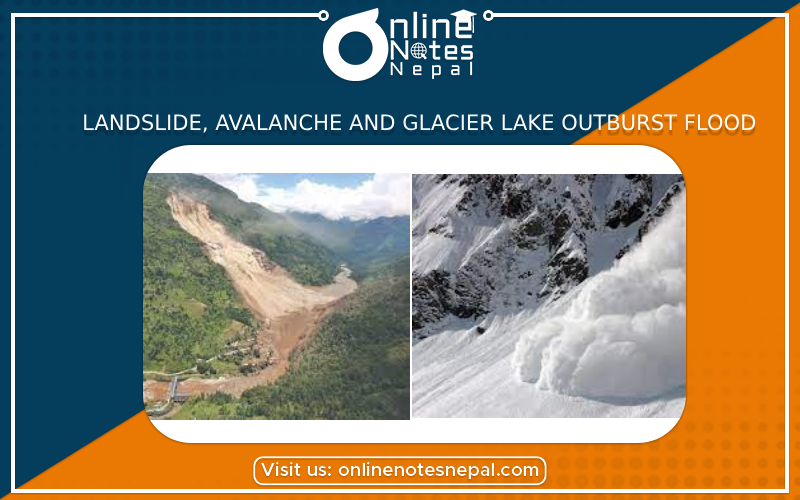Published by: Mandira
Published date: 12 Jan 2022

Landslide
A landslide is also known as landslip, is the downward movement of soil, rock, debris or vegetation due to gravitational force. A landslide can also occur inside the water, called the submarine landslide. Gravitational force is not only the causes of landslide but there are also other causes of deforestation, earthquake etc. Landslide is also one of the common natural disasters of Nepal. They occur usually in hilly and mountain regions of Nepal.
The landslide causes huge loss of life and human properties. It washes away trees and vegetation. It blocks highways and kills many people. Sometimes it also blocks the river that causes flooding. Lands with less vegetation and forest, weak soil support, and more inclination are like to face landslide.
Causes of Landslide
Consequences of Landslide
Preventive Measures of Landslide
Avalanche
Avalanche is a type of natural disaster that occurs in mountains region. It is the downward flow of the mass of snow, ice, and rocks from the mountain slope. In winter, avalanches are caused when fresh snow falls and slips off the snow surfaces. Similarly, in the spring season, they occur when partly thawed snow rolls down mountain slopes. The avalanche moves at very high speed. Sometimes they achieve velocities as high as 400 km per hour. Avalanches can reach speeds of 80 mph within about 5 seconds. Most avalanches occur between 30 and 45 degrees, on a slope that faces the north, east, and northeast directions.
They also cause huge loss of life and properties when the enter the human civilization in mountain regions. They also kill mountaineers. Each year avalanche kills more than 150 people all over the world. There are various causes of the avalanche. Some of the causes of avalanche are discussed below:
Causes
Effects of avalanche
Avalanche also causes loss of life and properties when it enters human civilization areas in mountain regions. People who enjoy skiing, snowboarding and snowmobiling are at a greater risk of losing their lives. Powerful avalanche can block roads and may damage power supplies. It also causes flash floods. It also economically affects the tourism sector that is associated with mountain regions.
Preventive Measures
Glacier Lake Outburst Flood ( GLOF)
A glacier is a persistent body of dense ice that is constantly moving under its own weight. It forms where the accumulation of snow exceeds. In our country Nepal there are lots of mountains which is cover by snow. About 15 % of the mountain are susceptible to Glacial Lake Outburst Floods ( GLOF ). The most of the mountain are with the average elevation of 4 ,500 m above which are mostly covered with snow. The high glacier mountains have been experiencing fast melting, result in the formation of a large number of glacial lakes .
When the water come down from the mountains and start to make a lake. The glacial lake outburst makes the flood. It occurs when it contains a glacial lake fails. As we know during the flood thousand of people, hundred of villages and basic infrastructure such as house bridges, building etc are in danger during the flood. All the climate or global change invited environment in trouble and disasters in the Hindu-Kush Himalayan region including Nepal .
Cause of GLOF
There are various factors that are trigger the GLOF events in the snow peaked mountain region, Some of them are given below:
Trend of GLOF Events in Nepal
The scientists from the UNEP and ICIMOD identified 3,252 glaciers lakes in Nepal. It has at least 24 GLOF events in the past and 14 are said or believed to have occurred by Nepal itself and 10 were the result of flood overspills across the China-Nepal border. Nepal was conducted to an aim of development for the adoption of GLOF's trouble in Nepal which gives to develop overall risk from GLOF in the upcoming days .
Table : Glacier Lake Outburst Flood ( GLOF ) Events in Nepal in Different Time Period:
| SN | Date | River basin | Lake | Cause | Losses |
| 1 | 450 years ago | Seti Khola | Machha puchchhre | Moraine collapse | Pokhara valley covered by 50-60 meter deep debris |
| 2 | 3rd Sep 1977 | Dudh Koshi | Nare | Moraine collapse | Human live bridges other |
| 3 | 23 rd Jun 1980 | Tamor | Nagma pokhari | Moraine collapse | Villages destroyed 71km from source |
| 4 | 4thAug 1985 | Dudh Koshi | Dig Tsho | Moraine collapse | Human lives, Namche small hydropower station , 14 bridges etc. |
| 5 | 12th Jul 1991 | Tama Koshi | Chubung | Moraine collapse | House , farmland , etc. |
| 6 | 3rd Sep 1998 | Dudh Koshi | Chubung |
Moraine collapse |
Human lives and more than Rs.156 million |
| 7 | 15th Aug 2003 | Madi River | Kabache Lake | Moraine collapse | Not known |
| 8 | 8th Aug 2004 | Madi River | Kabache Lake | Moraine collapse | Not known |
| 9 | Unknown | Arun | Barun Khola | Moraine collapse | Not known |
| 10 | Unknown | Arun | Barun Khola | Moraine collapse | Not known |
| 11 | Unknown | Dudh Koshi | Chokarma Cho | Moraine collapse | Not known |
| 12 | Unknown | Kali Gandaki | Unnamed (Mustang ) | Moraine collapse | Not known |
| 13 | Unknown | Kali Gandaki | Unnamed (Mustang ) | Moraine collapse | Not known |
| 14 | Unknown | Mugu Karnali | Unnamed (Mustang ) | Moraine collapse | Not known |
| 15 | 5th May 212 | Seti River | Unnamed (Annapurna) | Avalanche | 20 human lives and damage to property |
Precautions